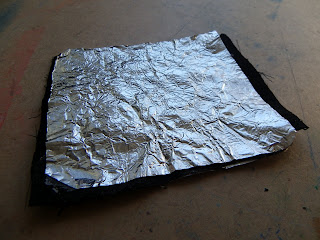As suggested by my tutor I tried out some material layer combinations to see what would work best for my hat. I also tried out some miniature hats to see how I could realistically make a simple hat out of tin foil.
This first sample was a layer of black generic fabric, possibly polyester, between two layers of tin foil. It was a fairly good combination, although the glue did take a while to dry.
This sample was the same as the first but with an extra layer of ironed out plastic bag in between. I had some left over from a previous creative venture so decided to try it out. But it was a little thick and rigid for the main material of a hat, perhaps I could use it for decorative structured elements instead.
This next sample was the same as the first but with a layer of fine plastic mesh. I thought this would make the fabric more stable structurally and also give the material a nice surface texture. This was a pretty good combination, but it was a little stiffer than the first so maybe not as ideal.
This next sample was the fine plastic mesh between tin foil layers. It dried a lot quicker than the others but did not have as much structural integrity so would not be a an ideal construction material.
I have decided to use a composite material made from a layer of tin foil then the black fabric then this tissue paper and another tin foil layer. I believe this will give me the structural capabilities that I need and also a complex enough layer design to draw and feature on the product label.
The next few photographs are of folding experiments. I was trying to work out a way of making a hat out of a flat sheet by folding at various points in order to make the hat shape. In the first try I folded in four places, which worked quite well but made the hat quite cube-like.
In my second try I made five folds (shown here on the right) which made the design much more spherical. I will be employing this method in order to make the base of my hat. I will then build upon that with more tin foil to expand and improve the design.
The picture below shows the corner of the composite fabric I plan to use for my hat. Here I am just about the glue down the last corner of the last foil layer.
I now just have to wait for this large piece to dry and I can begin constructing my hat.





































































